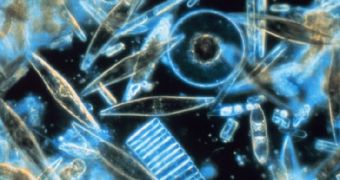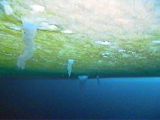At first sight, ice and life are two notions that exclude each other, as they have nothing in common.
If we look at an ice cube taken from the fridge, we will see just a cold and transparent particle. But if we examine at a microscope a piece of ice picked from a polar sheet, a whole universe of microorganisms will open in front of our eyes.
Extremely abundant are monocellular tiny algae with a lens or spherical shape. They make photosynthesis and some use atmospheric nitrogen. Numerous other organisms, mostly protozoans, move graciously and slowly, some with a cylindrical shape and moving with snake-like contortions, feeding on the algae and also bacteria.
The ice bacteria are even able to interact and modify the ice.
Chryseobacterium sp. produces Ice Recrystallisation Inhibition (IRI). These bacteria can be used in ice-cream industry because they prevent ice-cream from recrystallizing and becoming 'crunchy'. Some species trigger the formation of ice crystals at temperatures close to melting.
Pseudomonas borealis not only produces ice, but is tolerant to cold (common bacteria stop their activity at low temperatures).
On the polar ice shelf over 2000 algae and animal species have been found, most of them attached to the submarine surface of the ice.
Many penetrate into the thickness of the ice and remain on the white caverns. They pass the winter in a latent stage (called cyst) and in the spring they wake up to life. The cysts can stand even over a century and revive when the conditions are right.
The existence conditions under ice are better than at its upper limit, where sudden and great temperature variations are recorded. Because ice is teaming with life, polar researchers have had many times to see a curious phenomenon: a crack in the ice when temperature got up over -15o C.
How can this be possible when everything around is frozen due to low temperatures? When the temperatures start to go up, the microorganisms get out of the latent life. The sun helps the algae multiplication. The huge number of algae cells absorb the solar radiations and after that release it into the ice, of course, at a very small scale. Even so, due to their huge number, overpassing billions on a square meter, the total amount of warmth makes the ice crack in many places.
But the ice microorganisms trigger another curious phenomenon: if you walk on the ice shelf on the Antarctic or the Arctic, you will surely be very amazed by the reddish color of the ice, very similar to raspberry syrup.
The color stretches over large areas and the phenomenon occurs only in spring. This color comes from the algae; most are red, but there are also green and blue-green algae.
Sometimes, the algae give a distinctly red, green or blue-green color to the top of the icebergs. Till now scientists identified about 300 species associated with the "red glaciers" phenomenon.
The red color is given by red protective carotenoid chemicals that the alga produces against high concentrations of visible and ultra violet light reflected by the snow and ice surfaces, which can be destructive. Such algae are also found in high mountain glaciers.
When you walk across red ice, the footprints you leave are even redder as the algae are concentrated when the snow is crushed and sometimes a slight smell of fresh watermelon accompanies the phenomenon. The abundance of life found on ice gives hope to researchers that life could be found on Mars, a frozen planet.

 14 DAY TRIAL //
14 DAY TRIAL // 
